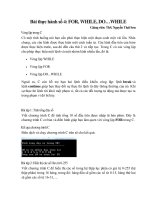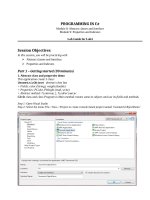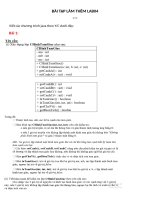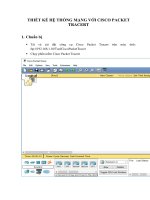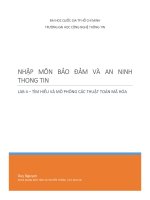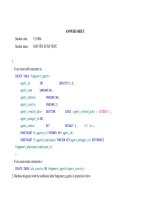Lab04 1513804
Bạn đang xem bản rút gọn của tài liệu. Xem và tải ngay bản đầy đủ của tài liệu tại đây (339.42 KB, 4 trang )
HỌ TÊN
: NGUYỄN XUÂN TRỰC
MSSV
: 1513804
==================o0o==================
1) Select the first ICMP Echo Request message sent by your computer, and expand the
Internet Protocol part of the packet in the packet details window.
SOLUTION
According to the figure 1, the IP address of my computer is 192.168.1.102
2) Within the IP packet header, what is the value in the upper layer protocol field?
SOLUTION
According to the figure 1, within the IP packet header, the value in the upper layer
protocol field is ICMP (1).
3) How many bytes are in the IP header? How many bytes are in the payload of the IP
datagram? Explain how you determined the number of payload bytes.
SOLUTION
According to the figure 1, the header length is 20 bytes and the total length is 84 bytes.
Therefore, the payload of the IP datagram should be 64 bytes (84 bytes – 20 bytes).
4) Has this IP datagram been fragmented? Explain how you determined whether or not
the datagram has been fragmented.
SOLUTION
According to the figure 1, under flags section, the more fragments bit = 0, so the data is
not fragmented.
5) Which fields in the IP datagram always change from one datagram to the next within
this series of ICMP messages sent by your computer?
SOLUTION
According to above two screenshots, identification, Time to live and Header checksum
always change.
6) Which fields stay constant? Which of the fields must stay constant? Which fields
must change? Why?
SOLUTION
The fields that stay constant are: Version (since we are using IPv4), header length (since
these are UDP packets), source IP (since all packets are sent from my computer),
destination IP (since we are sending to the same host), Differentiated Services (since all
packets are UDP), Upper Layer Protocol (since these are UDP packets)
The fields that must stay constant are: Version (since we are using IPv4), header length
(since these are UDP packets), source IP (since all packets are sent from my computer),
destination IP (since we are sending to the same host), Differentiated Services (since all
packets are UDP), Upper Layer Protocol (since these are UDP packets)
The fields that must change are: Identification (IP packets have different ids), Time to
live (traceroute increments each packet), Header checksum (since header changes)
7) Describe the pattern you see in the values in the Identification field of the IP datagram
8) What is the value in the Identification field and the TTL field?
SOLUTION
According to above screenshot, Identification: 13008, TTL: 1
9) Do these values remain unchanged for all of the ICMP TTL-exceeded replies sent to
your computer by the nearest (first hop) router? Why?
SOLUTION
The values of identification field changes for all the ICMP TTL‐exceeded replies since
the identification field is a unique value. If two or more IP datagrams have the same
identification value, then it means that these IP datagrams are fragments of a single
large IP datagram.
The TTL field was unchanged since the TTL for the nearest router is always the same
(Windown, TTL 1).
10) Find the first ICMP Echo Request message that was sent by your computer after
you changed the Packet Size in pingplotter to be 2000. Has that message been
fragmented across more than one IP datagram?
SOLUTION

